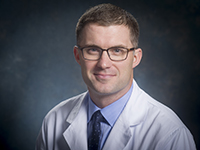 UAB Department of Surgery Assistant Professor Graeme McFarland, M.D., was awarded $10,000 in funding through the UAB Faculty Development Grant Program (FDGP). McFarland also serves as the co-director of the UAB Advanced Limb Preservation Clinic and Associate Director of the General Surgery Residency Program.
UAB Department of Surgery Assistant Professor Graeme McFarland, M.D., was awarded $10,000 in funding through the UAB Faculty Development Grant Program (FDGP). McFarland also serves as the co-director of the UAB Advanced Limb Preservation Clinic and Associate Director of the General Surgery Residency Program.
The UAB FDGP is designed to provide funding for faculty to develop manuscripts, publications, presentations, grant applications, future research initiatives, creative works, scholarly activity and new skills to enhance peer recognition outside of UAB. The program is only open to applicants who meet certain guidelines, such as being an assistant professor, among others.
To be considered for the FDGP, faculty members must nominate themselves or be nominated by other faculty. The nominations are then reviewed and voted upon by the faculty senate. The Department of Surgery will match the $5,000 in grant funds, which gives McFarland a total of $10,000 in available funding.
The grant period is roughly one year, beginning May 2020, and at the end of the year, recipients of the UAB FDGP will present their use of funds during a poster session and will also submit a final report.
McFarland plans to use his funding to conduct a prospective trial evaluating a new technology called two-dimensional angiography. This technology allows surgeons performing lower-extremity revascularization procedures for peripheral artery disease to determine the overall arterial perfusion of the limb and how effective the intervention has been.
Two-dimensional angiography technology can be used in real-time in the operating room to assist with clinical decision-making, which allows the opportunity for further intervention to be done if needed during the initial operation. Currently, most methods are typically done post-operatively.
“We expect this technology to improve outcomes for patients with the threat of limb loss due to peripheral artery disease,” said McFarland. “The hope is that this technology ultimately improves limb salvage rates, providing for a better quality of life for the patient. If this is the case, this technology could change the way we evaluate and treat this challenging patient population.”
To read more about the FDGP, visit the Faculty Senate information website.